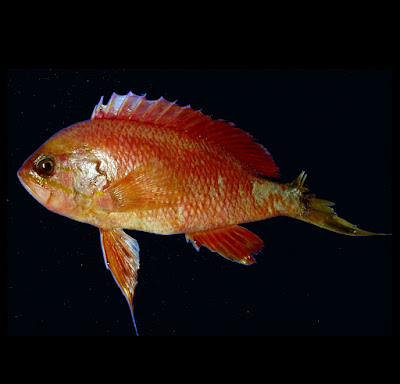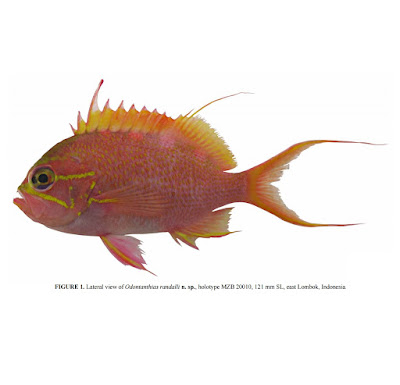[Most Recent Entries] [Calendar View]
Saturday, July 23rd, 2016
| Time | Event | ||||
| 5:29a | [Ichthyology • 2016] Odontanthias cauoh • A New Species of Anthiadinae (Teleostei: Serranidae) from São Pedro and São Paulo Archipelago, Brazil, Equatorial Atlantic
Abstract A new species of Anthiadinae, Odontanthias cauoh, is described from São Pedro and São Paulo Archipelago (SPSPA), Brazil, Equatorial Atlantic. The new species differs from its only Atlantic congener by a combination of several characters: pectoral-fin rays 20; total gill rakers on first arch 39; vomerine tooth patch with a posterior prolongation; pelvic fin not reaching base of last anal-fin ray; dorsal, anal and pelvic fins scaleless; and coloration (dorsal, anal, and pelvic fins mostly dark red). The record of the new species contributes to increase the fish endemism in SPSPA. Keywords: Pisces, Odontanthias cauoh, taxonomy, oceanic islands, endemism
Diagnosis. The new species differs from its only Atlantic congener by a combination of several characters: pectoral-fin rays 20; total gill rakers on first arch 39; vomerine tooth patch with a posterior prolongation; pelvic fin not reaching base of last anal-fin ray; dorsal, anal, and pelvic fins scaleless; and coloration (dorsal, anal, and pelvic fins mostly dark red). Distribution. Odontanthias cauoh sp. n. is currently known only from São Pedro and São Paulo Archipelago, Brazil, Western Central Atlantic (Fig. 1). No data about its depth range is available. Etymology. The new species is named after the popular name given by the professional fishermen to the fish at St. Paul’s Rocks, “Carolina”, shortened to the nickname (Cauó) of the first author’s elder daughter, Ana Carolina S.R. Carvalho, pronounced as “kau-oh”. Proposed English name: Red Jewelfish due to the color of the known specimen. Proposed Portuguese (Brazilian) name: Carolina. Biological aspects. The stomach of the holotype was examined and found to be empty, with no trace of biological material. The gonads were analyzed macroscopically, indicating an immature female specimen. Alfredo Carvalho-Filho, Bruno César Luz Macena and Diogo Martins Nunes. 2016. A New Species of Anthiadinae (Teleostei: Serranidae) from São Pedro and São Paulo Archipelago, Brazil, Equatorial Atlantic. Zootaxa. 4139(4); 585–592. DOI: 10.11646/zootaxa.4139.4.10 | ||||
| 6:05a | [Ichthyology • 2011] Odontanthias randalli • A New Anthiine Fish (Serranidae: Anthiinae) from East Lombok, Indonesia
Abstract Odontanthias randalli, a new species of anthiine serranid fish from southeastern Indonesia, is described, bringing the number of known species in the genus to 14. The new species is clearly distinguished from other members of the genus by the following combination of characters: dorsal-fin soft rays 16–17, lateral-line scales 37 to 39, 3rd dorsal spine longest, 3rd dorsal-fin soft ray the only filamentous dorsal-fin ray, caudal fin lunate with extremely long filamentous lobes, depth of body 2.2 to 2. 5 in SL, vomerine-tooth patch arrowhead shaped, and body pinkish with bright yellow spots on upper half and four pale pink blotches below dorsal-fin base. The new species is compared with other members of the genus. Key words: Odontanthias, Serranidae, new species, Indo-Pacific, Indonesia
Diagnosis. Dorsal rays X, 16–17; anal rays III, 7; pectoral rays 15–16; lateral-line scales 37–39; gill rakers 10–13 + 21–27 (total = 32–39); body depth 2.2–2.5 in SL; spine at angle of preopercle moderately long, extending about half distance to margin of subopercle; vomerine tooth patch arrowhead-shaped; no teeth on mesopterygoids; scales dorsally on snout nearly reaching upper lip; 3rd dorsal spine elongate, 1.36–2.32 in head length; 3rd ray of dorsal fin the longest, greatly produced as a long filament; 2nd anal spine subequal to third, 2.32–2.78 in head length; caudal fin lunate, the lobes very long and filamentous, fin length 1.37–2.01 in SL. Colour when fresh mostly pink; scales on upper half of body each with a bright yellow spot; head pinkish with a vivid yellow, horizontal V-shaped marking originating on snout tip and extending posteriorly as two stripes; lower stripe running posteroventrally below eye to edge of opercle; upper stripe running posterodorsally through about the middle of eye to edge of the opercle just above primary opercular spine; nape yellowish; four pale pinkish blotches present below dorsal fin base; dorsal fin mostly yellow with some pink areas; anal fin pinkish with yellow pigment between second and third spines extending on to posterior portion of posteriorly adjacent fin membranes; caudal fin mostly pink with yellow pigment basally and extending along centre of filamentous lobes; pectoral fins pinkish with yellow stripe on anterior third extending from base of fin to about one-third distance of longest rays; pelvic fin mostly pink with yellow pigment on membrane between first and second soft rays. Distribution. Currently known only from East Lombok in the Nusa Tenggara region of Indonesia. All type specimens were collected from the fish market at Tanjung Luar from handline fishers operating in local waters. Etymology. Named after John E. Randall, who has made such a significant contribution to the knowledge of anthiine fishes, and Indo–Pacific fishes in general. The review of the Odontanthias genus he co-authored provided detailed description of the nominal species and their relationships with closely related genera. Proposed vernacular name: Lombok Swallowtail William T. White. 2011. Odontanthias randalli n. sp., A New Anthiine Fish (Serranidae: Anthiinae) from Indonesia. Zootaxa. 3015: 21–28. | ||||
| 6:19a | [Ichthyology • 2012] Odontanthias hensleyi • A New Species of Odontanthias Bleeker (Perciformes: Serranidae: Anthiinae) from Mona Passage off Puerto Rico, the First Record of the Genus from the Atlantic Ocean
Abstract Odontanthias hensleyi, a new species of anthiine serranid fish, is described from four specimens collected off the west coast of Puerto Rico in Mona Passage. This is the first Atlantic record for the genus Odontanthias, heretofore known from 13 Indo-Pacific species. The new species is distinguished from all other species of Odontanthias by the following combination of characters: 15 soft rays in the dorsal fin, 18 pectoral fin rays, vomerine tooth patch subquadrangular to diamond-shaped without posterior prolongation, pelvic fin and caudal fin lobes very well produced, and coloration (side of head with two bright yellow stripes; pelvic, anal and caudal fins bright yellow). Anderson, W.D.Jr. and García-Moliner, G. 2012. A New Species of Odontanthias Bleeker (Perciformes: Serranidae: Anthiinae) from Mona Passage off Puerto Rico, the First Record of the Genus from the Atlantic Ocean. aqua, International Journal of Ichthyology, 18 (1): 25-30. | ||||
| 9:24a | [Herpetology • 2016] Drymarchon kolpobasileus • A Cryptic New Species of Indigo Snake (Genus Drymarchon) from the Florida Platform of the United States Abstract Indigo Snakes (genus Drymarchon) occur from northern Argentina northward into to the United States, where they inhabit southern Texas and disjunct populations in Mississippi, Florida and Georgia. Based on allopatry and morphological differences Collins (1991) hypothesized that the two United States taxa—the Western Indigo Snake, D. melanurus erebennus (Cope, 1860), and the Eastern Indigo Snake, D. couperi (Holbrook, 1842)—deserved full species recognition. Building upon this hypothesis with molecular and morphological analyses we illustrate that D. couperi is split into two distinct lineages. Based on the General Lineage Concept of Species, we describe the lineage that occurs along the Gulf coast of Florida and Mississippi as a new species, Drymarchon kolpobasileus. The new species is distinguished from D. couperi by a suite of morphological features, including a shorter and shallower head, deeper and shorter 7th infralabial scales, and shorter temporal scales. Overall, the presence of a deep 7th infralabial scale provides the best univariate identifier of D. kolpobasileus sp. nov. This study illustrates the usefulness of using both morphological and genetic data in refining accurate descriptions of geographical distributions. Keywords: Reptilia, Colubridae, Drymarchon couperi, Drymarchon melanurus, Drymarchon kolpobasileus sp. nov., Indigo Snakes, morphology, phylogenetics, Pleistocene, Pliocene, Serpentes, United States Krysko, Kenneth L., Michael C. Granatosky, Leroy P. Nuñez & Daniel J. Smith. 2016. A Cryptic New Species of Indigo Snake (Genus Drymarchon) from the Florida Platform of the United States. Zootaxa. 4138(3): 549–569. DOI: 10.11646/zootaxa.4138.3.9 |
| << Previous Day |
2016/07/23 [Calendar] |
Next Day >> |













